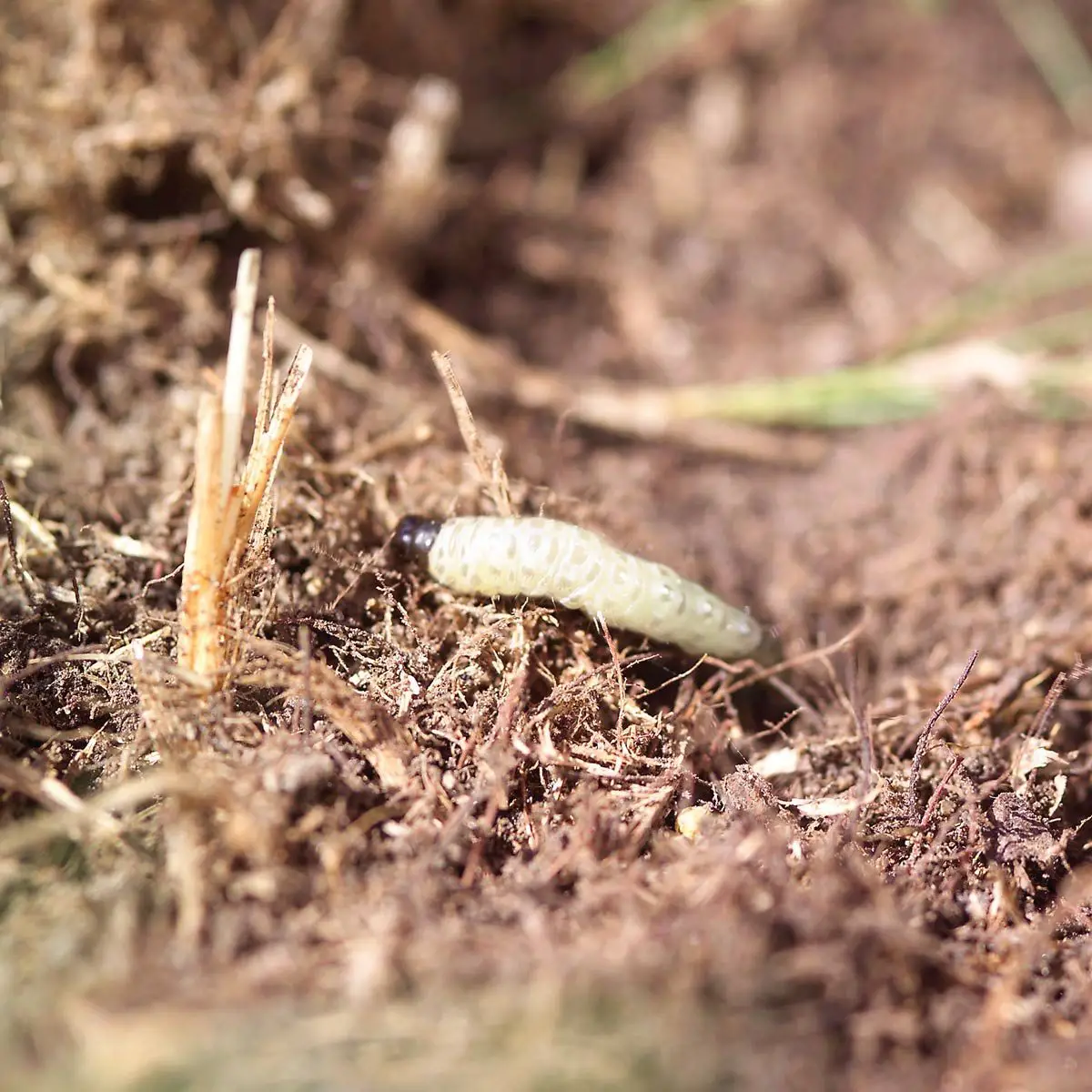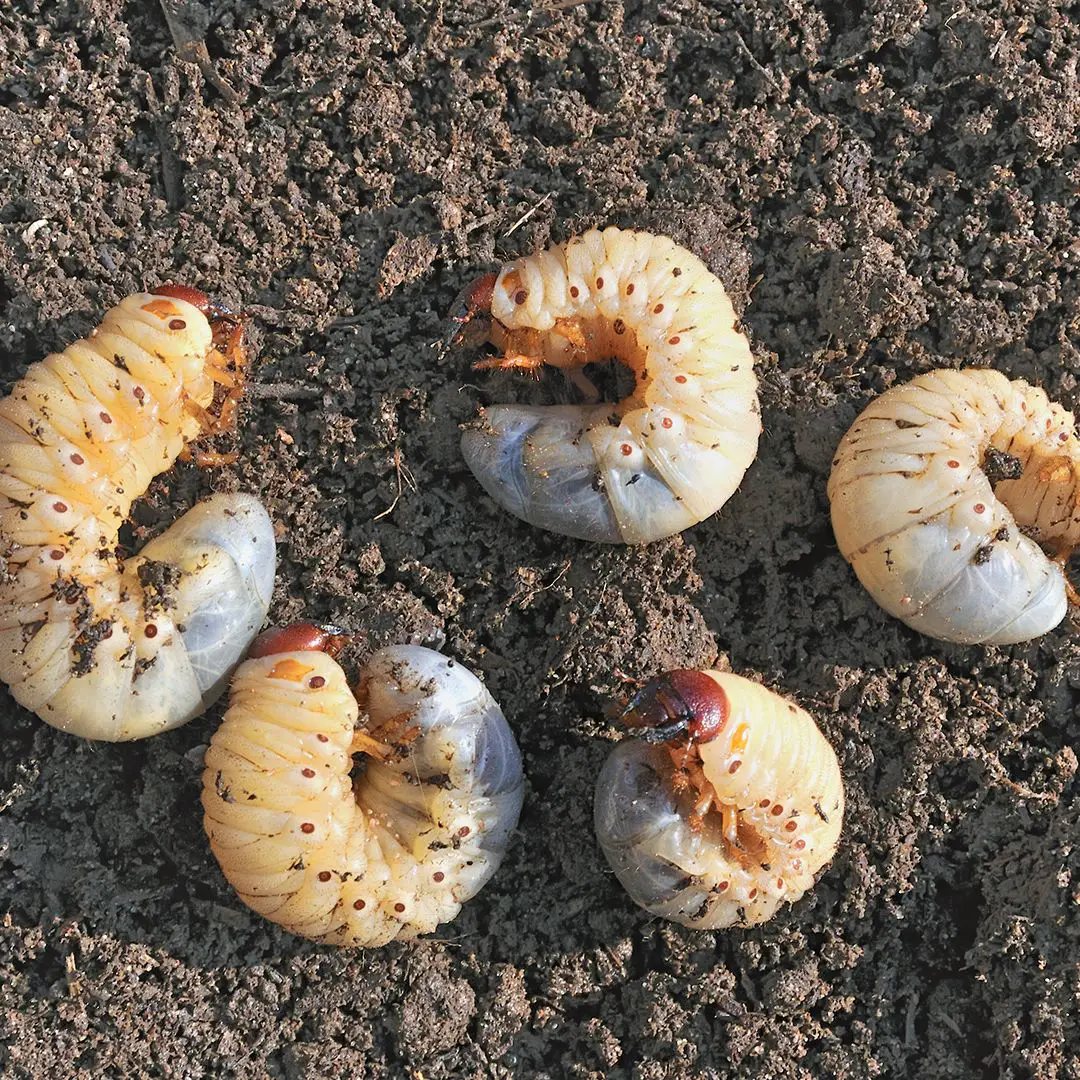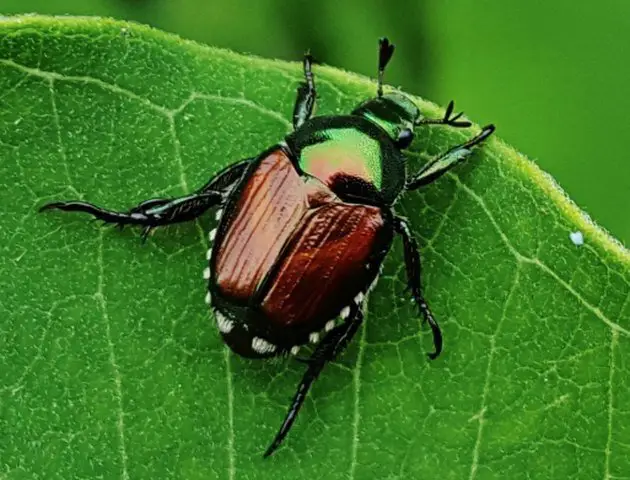Telltale Signs Your Lawn Has A Grub Problem
Most people recognize that lawn grubs, while common, can cause significant property damage. Also known as white grubs, these immature beetles multiply rapidly and have a voracious appetite. In just a short span of time, these C-shaped larvae burrow under the surface layer of a lawn, devouring plant roots and other organic soil matter, eventually causing large sections of grass to weaken and die. The grubs that make it into maturity grow into adult beetles, which return to the soil to lay their eggs, perpetuating both the cycle of life and destruction of your property.
How Do Grubs Damage Your Lawn
Lawn grubs are not really harmful in small numbers, but if large populations are left unchecked, they can wreak havoc on your lawn. All grasses can handle grub feeding to some extent, but healthier grass can tolerate more. Nevertheless, turf eaten by grubs gradually thins and becomes patchy with bare spots that will grow larger over time.
Grub infestations are often accompanied by animals such as birds, raccoons, and moles digging up your lawn to find and feed on these juicy beetle larvae. This is not only harmful to your grasss health but also ruins your lawns aesthetics.
Short Grass = Short Roots
The roots of your grass will be about as long as the blades are allowed to grow. For example, if you cut your grass down to 2 inches every week, youre likely to have roots of only 2 inches or less. If you allow your grass to grow up to 4 inches before cutting it down to 3 every few weeks, youre likely to have roots of 4 inches in length.
Simply put, deeper roots mean that the grass is less damaged by grubs. But if you have shallow grass roots, it makes it easier for the grubs to live in the top 2 to 3 inches of soil, their preferred zone.
You May Like: How Much Water Does My Lawn Need
Do Grubs Die In The Winter
Every living creature has birth and death. As the grubs are born, so these will die in time naturally. Some questions knock to the mind of every lawn owner like how larvae are born, when these grubs get birth when they will die, do grubs die in winter, etc. However, in this section, we will give you more information about Do Grubs Die in the Winter?
The straight answer is NO, grubs do not die just it is winter.
To get the precise concept regarding the above issue, you have to learn about the whole life cycle of the grubs. Lets begin to know about them below.
First, this procedure of the life cycle of the white grub larva starts with the Japanese beetles. The grubs collect their feeds from the soil by destroying grasses and lawns and staying alive during summer, winter, and spring.
In Jun or early July, the Japanese beetles fly around to mate each other. After mating, they lay about 60 eggs in the grass at your lawn. When they complete laying their eggs, the beetles stop to fly, and finally, they die naturally.
In the very first of August, eggs turn into larvae through the hatching system. These larvae are known as white grubs. The white grubs are C-shaped in position. During the season, caterpillars grow up to ¼ to ½ inches long. They live under the soil to keep them safe from the cold weather. These white grubs grow day by day under the ground and start feeding grassroots in your lawn. In this time, the garden is affected more by the cause of larvae.
How Do I Know If I Have Grubs

Many lawn issues that resemble grub damage can be caused by something else, including disease, drought stress, hairy chinch bugs, sod webworms, shade, compaction, and more. In the early spring, for example, many homeowners suspect grub damage because of the condition of their lawn after snow melt.
The only way to be sure that you have grubs is to scout for them in your lawn.
Depending on the size of your lawn, you may want to scout for grubs in several places in the lawn. Just because there are a lot of grubs, or not a lot of grubs, in a particular square foot doesnt mean that the entire lawn either does or doesnt have a grub infestation. You can focus your scouting on areas of the lawn that are showing symptoms of grub feeding.
As youre scouting for grubs in your lawn, take notes so you remember which areas of your lawn have high counts and which dont. This is important if and when you decide to treat the lawn.
Also Check: How To Kill Wild Grass In Lawn
Nematodes For Lawn Grub Control
Beneficial nematodes can be introduced into the affected lawns to control Grubs. These nematodes work efficiently.
The nematodes munch on the larval forms thus they also prevent future infestation to an extent. Ive tried this method of control and I can say it works.
You can buy such nematodes on amazon.
Signs Of Grub Damage In Your Lawn
Not sure whether you have grubs in your yard or not?
Here are a few sure-fire signs that will help you identify grub damage:
It can be tough to identify what grub damage looks like, especially since it often resembles other types of damage, like drought.
However, keeping an eye out for these six signs can help you stop grub damage in its tracks.
Don’t Miss: How To Fix Brown Spots In Your Lawn
How To Determine If Your Lawn Has A Grub Infestation
Its normal to have worms, grubs, and insects in your soil, and the presence of some grubs doesnt necessarily mean that you have a problem that requires treatment.
Fall and summer are the times of year at which grubs do the most damage to your lawn, attacking the roots of your grass, and if you see big patches of your lawn that are brown or dying , this is when you can identify a grub infestation.
Some of the signs of grub infestation are brown patches that are irregular in shape or if your lawn just appears generally unhealthy. There may also be small holes in the ground in which animals have been doing some digging.
And if you suddenly notice mole tunnels in your yard, they may have shown up because theres a grub buffet below the grass.
If your lawn looks like this do the following:
How To Prevent And Deal With Lawn Grubs
Kelly Burke is a professional turf manager for a manicured corporate campus in New England. He is accredited in organic land care and is a licensed pesticide applicator. He formerly managed the turfgrass as a golf course superintendent and has held several senior management positions at private country clubs overseeing high maintenance lawns.
Typical lawn grubs, often called white grubs, are white, C-shaped beetle larvae about a half-inch long. A grub may be the larvae of the masked chafer or European chafer, Japanese beetle, or other beetle species. Lawn grubs have soft bodies with legs near the head.
Read Also: Where To Buy Moss For Lawn
Fall Turf Grass Problems Grubs Might Be The Culprit
If you are noticing ugly, dead patches in your lawn, you might have an active population of white grubs. White grubs can cause serious damage to turfgrass. Their feeding injures plant roots, causing the turf to wilt and die.
Symptoms of grub damage include:
- Patchy areas of wilting, discolored or stressed turf that does not respond to irrigation.
- Large irregular patches of dead turf that can be rolled back like a loose carpet.
- Raccoons, skunks and crows tearing up the lawn .
How To Control Lawn Grubs
A few grubs aren’t a problem, but if you see lots of them when you turn the soil, take action.
If youve had problems in early summer with beetles, and by late summer dead patches of grass have appeared in your lawn, you probably have grubs. Grubs are the larvae of Japanese beetles, June beetles, chafers, and others. These white, C-shaped grubs feast on organic matter in the soil, including grass roots.
Read Also: How To Set Up Lawn Sprinkler System
To Deter Lawn Grubs Dethatch
But what are the most effective options for sustainable-minded lawn owners?
Preventive methods top Shetlars list for fighting grubs nonchemically. I emphasize a lot especially to lawn care and sport field managers to keep the thatch down to a minimum, Shetlar said. His key to this: fertilizing ones lawn with nitrogen only once per year, and doing it very strategically and judiciously, to quote Shetlar, usually in late October, early November.
He also mentions research from a University of Kentucky entomologist suggesting you should choose one species of turfgrass over another.
Professor Daniel. A. Potter has conclusively shown that the tall are much more tolerant of grub populations, said Shetlar, who then added, Where Kentucky bluegrass and perennial ryegrass will be damaged with eight to 10 grubs per square foot, the tall fescues usually require somewhere around 12 to 14 grubs per square foot before showing damage.
What about those common organic recommendations for killing lawn grubs online, such as milky spore disease or beneficial nematodes? The commercial milky spore disease is only for Japanese beetles, Shetlar warned. Even then, milky spore disease is a weak pathogen that results in 20% to 25% infection at best.
As for beneficial nematodes, Shetlar said, Theres a very steep learning curve to using the insect parasitic nematodes. They can only be effective when used curatively, and even then, only on small affected areas.
Use Neem Oil Or Azadirachtin

Azadirachtin is a component of neem oil. While many people think neem oil and Azadirachtin are the same things, neem oil contains very little Azadirachtin.
As such, people usually buy concentrated Azadirachtin to use on their lawns. According to one study, Azadirachtin application on Kentucky bluegrass killed Japanese beetles at 5x the products label rate.
Neem oil is another pest control option. Pure neem oil deters the grubs from feeding, growing, and laying eggs. For best results, mix neem oil with water and spray the diluted solution on affected areas.
Pros: Both options are affordable Azadirachtin is classified by the EPA as relatively non-toxic , while neem oil is considered non-toxic, which means it wont harm people or non-target organisms.
Cons: Both neem oil and Azadirachtin require regular reapplication despite its efficacy at killing larval Japanese beetles, Azadirachtin wont kill mature beetles or deter them from laying eggs.
Read Also: How To Estimate Lawn Mowing
Sign 02 Check The Grubs:
If you have found some symptoms of the grubs, your next step will be to examine insects physically. To do this work, follow the below steps.. Take a shovel for digging an affected area.. Using your shovel, dig a square foot of the affected area.. Dig an area about two inches deep.. Check the C-shaped worm or insects carefully with their legs.
If you found the larvae or worms or insects, it means there are grubs in the lawn.
How Do Pest Control Experts Get Rid Of Lawn Grubs
Many lawn care companies offer grub control plans that work in a more or less similar manner. First, a lawn care professional will visit your home and begin by inspecting the lawn for signs of lawn grubs and adult beetle activity.
Next, just before the beginning of the hatching season, insect control will be applied. The product gets absorbed by the soil and will remain in the root system to eliminate any grubs that hatch after applying the treatment.
Many lawn care providers also offer customized lawn care plans along with extra services that may be purchased, allowing you to tailor your treatment plan to your specific needs.
Don’t Miss: Do I Need To Overseed My Lawn
Do Grubs Turn Into Cicadas
Technically theyre called nymphs, not larvae. When cicadas progress from one stage of development to another, they molt, rather than pupate. When the eggs hatch, the cicadas dont look like a grub or maggot as you might expect instead they look like tiny termites or ants, with 6 legs and antennae.
How To Tell If You Have Grubs In Your Yard
Activities of birds and other animals often increase on a lawn in case of a grub infestation.
Photo by Carol
The most straightforward method for determining whether or not you have a grub problem is to search for irregular brown spots spread throughout the lawn. The grass will also be easy to rip in these spots and devoid of roots. However, there are many other ways to check a grub infestation, which are described below.
Recommended Reading: How To Kill Pigweed In Lawn
How Bad Are Grubs For The Lawn
Grubs, which are the larval, or immature, stage of several species of beetles and chafers, can damage a lawn by feeding on the roots of your grass. Healthier grass can tolerate more grub feeding, and all grass can tolerate some grub feeding.
A grub infestation will cause patches of thinning turf, and these patches will gradually increase in size. Often times grub damaged grass will pull out very easily at the roots.
What we often hear from homeowners is that they believe they have grubs because animals like moles, skunks, crows and racoons are digging in the lawn. This isnt a reliable clue, however, because grub infestations arent always accompanied by animal damage and animal damage doesnt always result from a grub infestation. These animals feed on other insects in the lawn, like earthworms, which are beneficial to the health of the lawn. That all said, if you do have grubs and animals are digging for them in the lawn, that can be detrimental to the health of your turf and to the appearance of your yard.
What Do White Grubs Look Like
White grubs are the larva, or young, of several kinds of beetles. The European Chafer and Japanese Beetle are two of the most common in the Toronto area and throughout Ontario.
The adults breed through the early Summer and lay eggs in your lawn, which hatch in mid-to late-August and begin to feed, causing grub damage to occur.
Also Check: Does Organic Lawn Care Work
Will Grub Killer Get Rid Of Moles
Moles love to eat grubs. Its their number one favorite food source. So, get rid of the grubs, and you get rid of the moles, right? Only maybe.
The problem is that grubs arent the only food moles eat. Moles are insectivores. The National Wildlife Federation says that they can eat their weight in bugs. Every day.
They love grubs, yes, but they will eat millipedes, snails, slugs, spiders, centipedes, beetles, earthworms, and bug larvae too.
How To Spot Grub Damage

A common tell-tale sign that you have grubs in your lawn is an increase in birds looking for a meal in your yard. Not only do grubs ruin your lawn themselves, but animals looking to eat grubs do damage as well. Raccoons, opossums, skunks, and moles all feast on grubs while digging up your yard.
Seeing yellow or brown dead spots is also a sign that grubs are eating your lawn. The grubs move around once theyve eaten an entire area so youll see continuous spots popping up around where these things travel.
Recommended Reading: How To Get Rid Of Ticks In Your Lawn
How To Get Rid Of Grubs Organically
Despite your best attempts at preventing grub worms, they still may become troublesome enough to warrant corrective measures if your lawn has brow patches that peel back like a carpet.
Please dont use grub killers based on synthetic chemicals. Most are made from a class of pesticides called neonictinoids. These chemicals are systemic, meaning theyre absorbed by the roots then carried throughout the plants vascular system where they also travel into the pollen and nectar.When you use these products on the lawn, they are also absorbed by nearby trees, shrubs, and flowers where pollinators feed. Avoid using them. They have recently been implicated in the decline of many insect species as well as birds.
Thankfully, all four types of grub worms are susceptible to the following natural product control that doesnt bring harm to pollinators and other non-target critters.
Read Also: How To Fix Dry Lawn